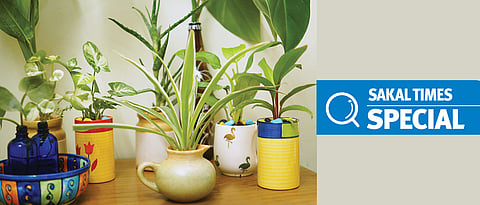

PUNE: Pollution is not just restricted to the air outside our homes, in fact, indoor air pollution is 12 times higher than the outdoor air pollution, said city-based researcher Dr Seemaa Ghate.
Ghate, who is researching a project on Phytoremediation (a process to reduce indoor pollution levels with the help of plants), said that there are a few varieties of plants that can help beat indoor pollution.
Ghate is one of the leading researchers in India on indoor pollution and the use of plants to minimise the levels of indoor pollution. Her project is based on the development of indoor greenery to reduce indoor pollution and the project has been given to her for the second time by the Department of Science and Technology (DST), New Delhi. The first project was given to Ghate from 2011 to 2013 and the second project is from 2017 to 2020. She has also been awarded a fellowship by the DST.
Ghate said, “From last 10 years, we are staying in non-ventilated houses and thus, indoor air pollution is increasing and is directly associating with allergies and chronic diseases.”
Talking about her project, she said, “The project includes quantification of poisonous pollutants released from mosquito coil, incense sticks, kitchen exhaust etc., and studying how a few varieties of plants can absorb pollutants from these sources and how the plants affect them.”
Explaining about her research, Ghate gave the example of a mosquito coil. She said that she kept three sets of plants in a room where the mosquito coil was burnt for seven to eight hours. The plants were exposed to the burning coil during the day and night hours. The pollutants that were released from the smoke of coil included particulate matter, Allethrins, Aldehydes, Benzene, Benzo[a]pyrene and Formaldehyde. She studied the effects of these pollutants on the set of plants.
Ghate further explained how pollutants are absorbed by a plant and what happens after that. “Even plants have a digestive system. When poisonous gases are released, the pollutant enters the plants’ system through the leaves or are absorbed through the medium (soil). They are metabolised by the bacteria present in the plant or the bacteria and charcoal which are inoculated in the soil. This process further breaks down the pollutant. Plants may use these substances formed by the breakdown of pollutants as nutrients. If it is not broken down or not required by the plant, then it may be stored in
the plant cells as a waste product or the plant may throw out the waste product through fallen leaves or roots,” Ghate said.
“There is no unit of pollution absorption by the plants, but the gaseous exchange in the plant is continuous. The position of plant indoors is important and it should be kept four feet from the place where one sits or stands or within the breathing zone of a person,” she added.
Nursery to help reduce indoor pollution
The research centre is situated in Pirangut Dravali and Ghate works at ‘Know How Foundation’ in Bavdhan area in the city.
According to Ghate’s research, incense sticks release sulphur dioxide, carbon monoxide, nitrogen dioxide, formaldehyde. Cigarette smoke releases nicotine and benzopyrene and kitchen smoke release carbon monoxide.
The plants tested by Ghate includes - Aglaonema commutatum (Chinese evergreen), Syngonium podophyllum (Arrowhead vine), Chlorophytum comosum, Polyscia fruticose (Ming aralia), Spathiphyllum wallisii (Peace lily or Nagphani), Sansevieria trifasciata (Agave or Ghaypat) and Epipremnum aureum (Pothos)
By the end of 2020, a phytoremediation nursery will be set up where there will be a standard pot, age of plant and medium along with bacteria and activated charcoal. This will be provided to the people who come with problems related to indoor pollution.
Recommendations will be also given on how much pollution per square cm of leaf absorbs and the per unit area of the room pollution that it absorbs.
Ghate has written a bilingual book (English and Marathi) called ‘Greening with eco-friendly plants’. The book describes 80 eco-friendly plants with their characteristics, light requirement, propagation, etc., that can be used as indoor plants to keep an area free from air pollution.
